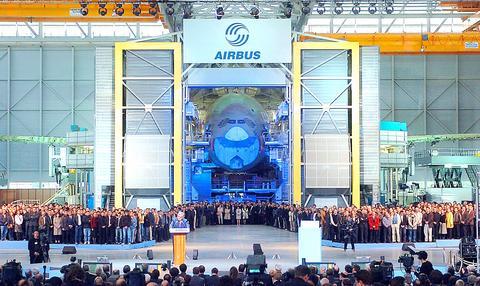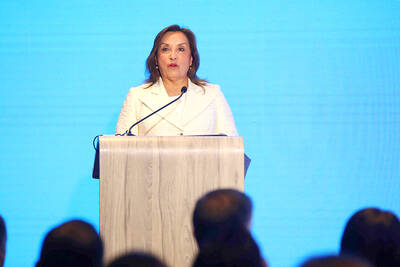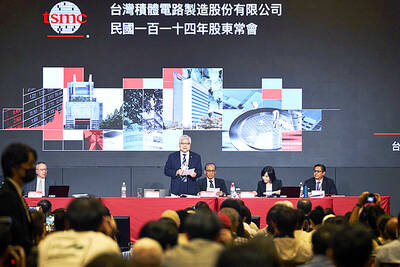Airbus offered a first peek at its colossal new double-decked jet Friday, inaugurating a cavernous factory here where the plane's components are to be gathered from production sites across Europe and clamped together to form the world's largest civilian aircraft. In a show that combined the upbeat speeches of a corporate pep rally with the thumping theatrics of a rock concert, Airbus parted a curtain to reveal the A380, minus its nose and with its fuselage obscured by scaffolding, but with wings spreading majestically 79.5m across the factory floor.
"This is not just the story of a magnificent airplane," said Noel Forgeard, the chief executive of Airbus, which is owned by Europe's aerospace industry. "It's a bright page in the history of a unified Europe."
Coming a week after the expansion of the European Union to 25 nations, which prompted less joy than ennui among many here, Airbus' presentation had the atmosphere of a belated European celebration.

PHOTO: AP
Airbus has already booked orders for 129 of the 555-seat planes, which will challenge the long dominance of Boeing's 747 in the jumbo jet category. While Airbus needs to sell at least 250 to break even, it is confident that the A380, which once seemed an almost foolhardy gamble, will be a success.
Last year, for the first time in its history, the company delivered more planes of all types than Boeing did, 305 versus 281. And it is expected to win more orders than its American archrival this year, for the fourth year in a row.
Boeing once bestrode commercial aviation, but it has been damaged by a scandal over its government lobbying, by turmoil in its executive suite and by a sense that it has throttled back its ambitions. Its main new project now is the 7E7, a much more modest jet meant to be highly efficient.
An almost cocky tone was evident in some of the remarks made by Airbus executives about the competition.
After Airbus gave the go-ahead for the A380 in late 2000, said one top executive, Gerard Blanc, Boeing was "petrified."
"They tried to react, but they couldn't," Blanc told a receptive crowd that included the prime minister of France, Jean-Pierre Raffarin. "They tried to launch an aircraft, any aircraft. But they didn't."
Analysts say it is not yet clear whether Airbus or Boeing made the right bet on the future of air travel. The sharp differences between the companies' visions -- with Airbus predicting a world of jumbo jets connecting busy hubs like London and Hong Kong and Boeing foreseeing smaller planes hopping directly between cities, has made this one of the starkest battles in business.
"The tendency will be to push for newer, more efficient aircraft," said Charles Champion, the head of the A380 project. "But smaller aircraft does not necessarily mean more efficient."
The A380 unveiled here will never fly: It will be used instead to conduct a battery of tests on the ground. The first airworthy plane is due to be assembled by July and make a maiden flight early next year. The A380 is scheduled to go into commercial service in the second quarter of 2006, initially with Singapore Airlines.
So far, Airbus has lined up 11 airlines to buy A380s, including Air France, Korean Air, Lufthansa and Qantas. In an order that gave the project crucial momentum, Emirates, an airline based in Dubai, agreed last year to take delivery of 41 A380s configured for passengers and two set up for freight.
FedEx has signed up to buy 10 as freighters, but Airbus has not lured an American passenger carrier to order the plane. The company has also not added any new customers this year. Forgeard has said Airbus is in negotiations with four carriers; one of them is rumored to be in China. The company says it believes that it will meet its goal of signing one new customer a year.
"We have a rather hefty order book," Champion said, "and the issue is to find slots for new customers."
The A380 has a list price of US$250 million to US$280 million, depending on the features. Analysts say Airbus, like Boeing, offers discounts and other sales incentives to fill its order book.
Airbus likes to promote the A380 as a plane that could transform air travel by offering passengers more space. It has shown mock-ups of travelers relaxing around a bar, with staircases leading between levels. But skeptics say that in order to make the plane economically viable, airlines will probably cram it with many more seats than the 555 that Airbus advertises, perhaps as many as 840.
Airbus executives were reluctant to be drawn into discussions about the number of seats or the sales price at an event meant to celebrate how the plane is assembled, not how it is selling.
Indeed, the production of the A380 is a model of European integration. The largest parts of the fuselage are made in France and Germany; the wings in Britain; and parts of the tail section in Spain.
They are transported to Toulouse, in southwestern France, on a flotilla of ships and barges; then they are transferred to trucks and trailers to be hauled through city streets to the plant under cover of darkness. Once a plane is assembled, it will be flown to Hamburg to have the cabin installed.
The system is not without pitfalls. In Bordeaux, barges must carry chunks of the fuselage up the Garonne River under an 18th-century bridge that offers scant clearance. Airbus has installed padding on the underside of the bridge to prevent accidental scratches.
A bigger problem has cropped up in Britain, where the wings are manufactured in Broughton and transported down the River Dee to a harbor in Wales. Airbus says the port must be dredged to accommodate the Chinese-made cargo ship that carries the wings to France. But environmental authorities there are resisting.
Champion said he was confident that Airbus would negotiate a compromise. Given the political symbolism attached to the project, it is hard to imagine that such a dispute would be allowed to ground it.
Now that Airbus has lifted the veil from its long-awaited airplane, the pressure will mount to put the A380 in the air. Airbus officials say they expect it to make its debut at the Paris Air Show next year.

With an approval rating of just two percent, Peruvian President Dina Boluarte might be the world’s most unpopular leader, according to pollsters. Protests greeted her rise to power 29 months ago, and have marked her entire term — joined by assorted scandals, investigations, controversies and a surge in gang violence. The 63-year-old is the target of a dozen probes, including for her alleged failure to declare gifts of luxury jewels and watches, a scandal inevitably dubbed “Rolexgate.” She is also under the microscope for a two-week undeclared absence for nose surgery — which she insists was medical, not cosmetic — and is

CAUTIOUS RECOVERY: While the manufacturing sector returned to growth amid the US-China trade truce, firms remain wary as uncertainty clouds the outlook, the CIER said The local manufacturing sector returned to expansion last month, as the official purchasing managers’ index (PMI) rose 2.1 points to 51.0, driven by a temporary easing in US-China trade tensions, the Chung-Hua Institution for Economic Research (CIER, 中華經濟研究院) said yesterday. The PMI gauges the health of the manufacturing industry, with readings above 50 indicating expansion and those below 50 signaling contraction. “Firms are not as pessimistic as they were in April, but they remain far from optimistic,” CIER president Lien Hsien-ming (連賢明) said at a news conference. The full impact of US tariff decisions is unlikely to become clear until later this month

GROWING CONCERN: Some senior Trump administration officials opposed the UAE expansion over fears that another TSMC project could jeopardize its US investment Taiwan Semiconductor Manufacturing Co (TSMC, 台積電) is evaluating building an advanced production facility in the United Arab Emirates (UAE) and has discussed the possibility with officials in US President Donald Trump’s administration, people familiar with the matter said, in a potentially major bet on the Middle East that would only come to fruition with Washington’s approval. The company has had multiple meetings in the past few months with US Special Envoy to the Middle East Steve Witkoff and officials from MGX, an influential investment vehicle overseen by the UAE president’s brother, the people said. The conversations are a continuation of talks that

CHIP DUTIES: TSMC said it voiced its concerns to Washington about tariffs, telling the US commerce department that it wants ‘fair treatment’ to protect its competitiveness Taiwan Semiconductor Manufacturing Co (TSMC, 台積電) yesterday reiterated robust business prospects for this year as strong artificial intelligence (AI) chip demand from Nvidia Corp and other customers would absorb the impacts of US tariffs. “The impact of tariffs would be indirect, as the custom tax is the importers’ responsibility, not the exporters,” TSMC chairman and chief executive officer C.C. Wei (魏哲家) said at the chipmaker’s annual shareholders’ meeting in Hsinchu City. TSMC’s business could be affected if people become reluctant to buy electronics due to inflated prices, Wei said. In addition, the chipmaker has voiced its concern to the US Department of Commerce